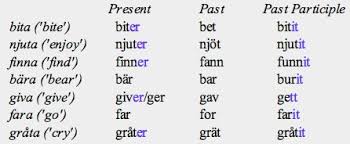Swedish Tenses: Overview of the Basics
Firstly, what are tenses? Tenses are verb forms that allow you to communicate time. When did something exist or happen? Conjugating verbs based on tenses is crucial because it completely changes the meaning of the rest of the sentence.
Take the two sentences: “We will eat the cake” and “We have eaten the cake”. Which sentence someone texts you might determine if you:
- Run home to get a slice of cake before it’s finished or
- Walk home slowly because there is no more cake to be had.
Let’s take a look at how many tenses Swedish learners will have to learn.
How many Swedish tenses are there?
There are five Swedish tenses that you, as a Swedish learner, need to gain an understanding of:
- Presens: The Swedish Present Tense
- Preteritum: The Swedish Simple Past Tense
- Perfekt: The Swedish Present Perfect Tense
- Pluskvamperfekt: The Swedish Past Perfect Tense
- Futurum: The Swedish Future Tense
Luckily, Swedish tenses have similar English equivalents, which gives English-speaking learners an advantage. Another piece of good news is that, unlike some languages, Swedish grammar doesn’t require you to conjugate verb endings based on the subject. The same verb forms are used for both singular and plural subject pronouns.
An introduction to Swedish verb groups
How many Swedish verb groups are there? Wait, why are we suddenly talking about verb groups? Well, to put the verbs in the correct forms to create tenses, we need to conjugate them. Unfortunately, not every Swedish verb will be conjugated in the same way.
To make sense of why they’re “changed” in different ways, we organize Swedish into different groups. Back to the question. How many Swedish verb groups are there? There are four different verb groups in Swedish.
- Group 1: Verbs where the stem form ends in an “a”.
- Group 2: Verbs where the stem form ends in a consonant.
- Group 3: Verbs where the stem form ends in a vowel which is not “a”.
- Group 4: Strong and irregular verbs.
As you can see, the first three groups are regular verbs, also called weak verbs. The fourth group consists of strong and irregular verbs.
But what is this “stem form” mentioned above? This is the basic form of each verb, which happens to be identical to the imperative form of verbs in Swedish. The imperative is the verb form you use when you give orders and tell people what to do. For example:
- Titta! = Listen! (Group 1)
- Läs! = Read! (Group 2)
- Tro! = Believe! (Group 3)
- Skriv! = Write! (Group 4)
Understanding this stem form is useful when studying Swedish grammar, as it will also help you see how other verb forms are built around this basic building block.
The Present: The Swedish Present Tense (Presens)
To talk about the present in Swedish, we use the present tense, or “presens”, as it is called in Swedish. We use the present tense to talk about things happening right now, things that usually happen, or things that will happen in the near future, for example:
- Jag äter just nu. = I am eating right now.
- Jag simmar varje torsdag. = I go swimming every Thursday.
- Jag går hem om 10 minuter. = I will go home in 10 minutes.
As you’ll notice, Swedish only has one present tense form. Many English speakers need to adjust to the idea that Swedish uses the same phrase where English speakers would use two. For example:
- Jag äter lunch där varje dag. = I eat lunch there every day.
- Jag äter lunch just nu. = I am eating lunch right now.
English uses the simple present (I eat) in the first sentence, but present continuous (I am eating) in the second sentence. Swedish uses “presens” for both.
Now, let’s look at some examples of how the present tense is formed in Swedish.
| Group | Rule | Stem | Present Tense |
| 1 | Stem + -r | Titta Fråga | Tittar Frågar |
| 2 | Stem + -er | Läs Ring | Läser Ringer |
| 3 | Stem + -r | Tro Må | Tror Mår |
| 4 | Irregular | Skriv Var | Skriver Är |

